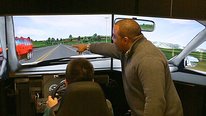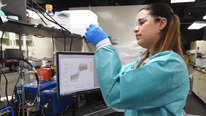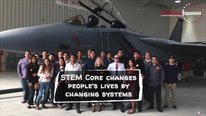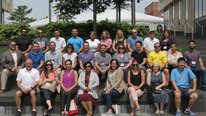- Sarah Lee
- http://sarahblee.me
- Assistant Department Head
- JROTC-CS Demonstration Project
- https://www.csforall.org/projects_and_programs/jrotc/
- Mississippi State University, Mississippi Coding Academies
- Ruthe Farmer
- https://www.linkedin.com/in/ruthefarmer/
- Chief Evangelist
- JROTC-CS Demonstration Project
- https://www.csforall.org/projects_and_programs/jrotc/
- CSForAll
- Todd Taylor
- http://www.linkedin.com/in/todd-taylor-2aa11952
- Chief, Program Development
- JROTC-CS Demonstration Project
- https://www.csforall.org/projects_and_programs/jrotc/
- Air Force Junior Reserve Officer Training Corps
Public Discussion
Continue the discussion of this presentation on the Multiplex. Go to Multiplex









Sarah Lee
Assistant Department Head
The JROTC-CS Demonstration Project is public-private partnership designed to bridge the CS education gap at Junior ROTC schools. Today, only 32% of Junior ROTC host high schools offer an Advanced Placement (AP) computer science course. The pilot will inform the development of a scalable model for CS and cybersecurity education to be deployed across the nationwide JROTC network of over 3400 high schools. The initial cohort of 30 schools represent 16 states and were selected from nearly 900 Air Force Junior ROTC host schools across the United States. These schools will receive school-level capacity building training, professional development for both teachers and Junior ROTC instructors, and internship, mentoring and scholarship opportunities for the students.
Collectively, these 30 schools serve more than 4000 Junior ROTC cadets and nearly 55K students overall. Half of the selected schools qualify as Title 1 (more than 50% of students receiving free or reduced lunch), and the total student population served is 58% minority and 48% female. JROTC provides a unique, scalable opportunity to prepare the tech leaders of tomorrow. The program consists of activities and mentoring across four years, including participation in CyberPatriot (freshman year), AP Computer Science Principles (sophomore year), a summer Cyber Academy (after junior year), and linkages to cybersecurity professionals during the senior year through internships and other touchpoints.
The Project is led by CSforALL in collaboration with the JROTC-CS Advisory Consortium Members including: Air Force Association’s CyberPatriot, U.S. Air Force Junior ROTC Headquarters, Capital One, Google, Intel Corporation, Lockheed Martin, Microsoft, Mississippi State University, National Initiative for Cybersecurity Education (NICE), National Integrated Cyber Education Research Center (NICERC), SANS Institute, Snap Inc., The College Board, and others as listed at https://www.csforall.org/projects_and_programs/...
Sarah Young
Director of Strategic Initiatives
I was moved by your video and the partnership with the JROTC. It's an ingenious combination of content and skills that are necessary for the future our national armed forces.
I am very interested to learn more about your next steps beyond the first cohort of 30 schools. What type of communication and dissemination efforts do you have planned to expand?
Sarah Lee
Ruthe Farmer
Chief Evangelist
We are working with the Air Force JROTC to prove the concept, and also working with the JROTC-CS Advisory Consortium to seek Congressional support and Federal funding for this effort within the DOD budget. Our model scales at 25-30K per school, so it will grow with funding. Additionally, we're talking with the other forces to begin onramping them to implement.
Sarah Young
Jennifer Vermillion
Director of Innovative Teaching and Learning
This is indeed an impressive partnership and project! I am curious to learn more about the initial pilot. Are you rolling out the opportunities for grades 9-12 at once or will students begin with the CyberPatriot program in grade 9 and move through the sequence?
Sarah Lee
Ruthe Farmer
Chief Evangelist
All grade levels are participating simultaneously, so there will be cadets at each grade level engaged in a phase of the program at all times. In this pilot, we selected a set of schools that included some with prior AP CS and CyberPatriot programs in place.
Walter Hernandez
Great video and honorable cause.
Chief Hernandez
Sarah Lee
Sarah Lee
Assistant Department Head
Thank you, Chief Hernandez. The JROTC program is comprised of approximately 545,000 students and more than half are racial minority students and 40 percent are female. This provides a great opportunity to broaden participation in computing among under-represented groups.
Janice Cuny
Global DIrestor of Align
This program had the possibility of having enormous impact!
I'm a little unsure of the logistics. From Ruthe's comments it looks like the current program is running in schools that already offer some computing classes. If that's true, are JROTC students required or encouraged to take those courses? Does that strain the capacity of those courses? Is supplementary material covered within the JRTOC program? How would this work when it reached a school that didn't have a CS program?
Sarah Lee
Ruthe Farmer
Chief Evangelist
Our pilot is with 30 schools that are a representative sample of Air Force JROTC partner schools. Currently only 32% of JROTC high schools offer AP CSP, and we know from the demographics that JROTC cadets are not enrolling in AP CSP at scale. The goal of the program is to build a scalable model that will:
This is accomplished in the following ways:
Some of the program content - participation in CyberPatriot, CyberStart and other related extra-curricular activities will be provided by the JROTC instructors. Additionally, the JROTC instructors will act as career coaches/advisors for the cadets.
The CS classes will be taught by a trained CS teacher and are available to the entire school. So, if a school doesn't have a CS class in place, we are leveraging the relationship with the Air Force to encourage the schools to put a class in place. Of the pilot schools, 12 do not yet have AP CSP in place but are on track to offer it in the fall of 2020.
Janice Cuny
Global DIrestor of Align
Thanks Ruthe. This project has the potential to reach a lot of students. In many cases, JROTC provides a strong cohort for students and encouraging/supporting that entire cohort to take CS could well change their school culture. It will be great to see how the program evolves!
What sort of data are you using for this first group of schools?
Sarah Lee
Sarah Lee
Assistant Department Head
Thank you for visiting our video! For this pilot, we are investigating the following:
1. What themes emerge through cadets’ reflections of their experiences with the summer cyber academy and the potential to integrate these skills in their educational pathways?
2. What is the increase in cadets’ knowledge and skills throughout the program?
3. What changes in cadets’ self-perceptions of cybersecurity learning are evident following the completion of the summer cyber academy?
4. To what degree, if any, does participation in the program impact cadets’ intention to study computer science and/or cybersecurity at school (by taking additional courses), in college, or in a career?
5. What differences are there, if any, across the first four questions in terms of participant gender, race/ethnicity, and socio-economic status and intersectionality of these demographics?
6. Based on experience feedback from instructors, curriculum designers, JROTC instructors, and participants, how could this model be scaled in the future? What time and resources (e.g., PD for teachers, lab resources, cadet housing, etc.) would be needed to bring this or a similar program to other locales? Could virtual instruction beyond the summer program be a path for enhancing and encouraging participants to stay engaged in cybersecurity and computer science?
Investigating questions 1 through 4 from a question 5 perspective supports inquiry into broader impacts and is a crucial component of the JROTC-CS initiative. Question 6 is more general, but is essential in being able to scale this program across the country so that more cadets are able to participate in this program.
Susan Warshaw
Th looks like an excellent program that focuses on a specific set of objectives and outcomes. I am wondering what this program does to improve math readiness for a degree in computer science?
Sarah Lee
Sarah Lee
Assistant Department Head
Hi Susan, thank you for watching our video. The scope of this project does not currently address K-12 math ed. However, as a higher ed faculty, I certainly understand the need for improvement in that area. Many of our incoming CS and software engineering majors have not received adequate preparation in math. Sometimes, they must take remedial math coursework to catch up. I assume you have also observed this. Often the math courses needed were available in their high school, but the student did not choose to take them. I think creating awareness among K-12 students of the math pathway that will best prepare them for a computing education/career pathway is something we can do in this project.
Susan Warshaw
Hi Sarah,
I believe a negative experience with math can be a deterrence for those interested in STEM fields. Glad to see you are aware of the situation and taking action.
Sarah Lee
Michael I. Swart
Great to see an initiative that would benefit all JROTC programs nationwide being piloted. Resources for both teachers and students, including PD, mentorship, internships, instruction... Can't wait to hear more about how the first cohort of students invited to the campus do as well as all the satellite programs. Thanks for sharing this work.
Sarah Lee
Assistant Department Head
Thank you for watching our video. We look forward to disseminating knowledge gained from the pilot.